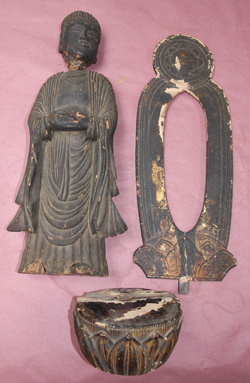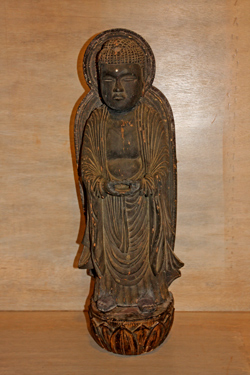Fine Antique Restoration
Here at Fine Antique Restoration, we do Chinese and Japanese lacquer
work, finishing of all styles and kinds of furniture repair. Richard
Morton, who began “fine Antique Restoration” has been
in business for over thirty years and uses integrity and expertise
in restoring heirloom museum pieces as well as contemporary furniture. In
every case the appropriate finishing material is chosen. Fine
Antique Restoration is expert at French Polishing for 18th century
and 19th century antique work. Marquetry and wood replacements
are always matched to the original as closely as possible. The
restoration of antique furniture is always gratifying. On
many pieces we can see the work of the previous restorer. By
working on them, we feel part of a long lineage of finishers and
wood workers.

Photo: Danielle Steele tray
Restoration of split through entire center of tray.
On contemporary woodwork, there is sometimes no call for French
Polishing which is a labor intensive but meditative technique of
hand applying shellac polish to a surface.

Photo: French Polished walnut bookcase on new construction by Mitch Berman.

"Rodman" Yacht with interior polyester finish
The piano finish for example often calls for use of “polyester” lacquer
which is a hand drying catalyzed epoxy lacquer. Generally
the sheen after rubbing up is very high and can only be achieved
with specialized equipment.
Most work we do is not hundereds of years old. They generally
are from 100 years old to completely new unfinished wood. Some
work however calls for a creative and esthetic handling with consideration
to the tastes of the owner. In the accompanying picture is
a music cabinet owned by the Ms. Nemi Frost of San Francisco.

The
finish produced here on Nemi Frost's music cabinet is a version of a Japanese finish known as “Negoro” which
involves sanding through from one colored lacquer to another.
As Richard lived and studied lacquer work in Japan, some work as
in the accompanying picture of a “Ming Dynasty” table
belonging to Mrs. Arlene Schnitzer and in some other lacquer
bowls owned by Buddhist priests, we use a natural lacquer coming
from the “Urushi” tree.

Pic of me with Schnitzer table
The lacquer is known as Urushi
and relates to Sumac. Pigments are mixed with Urushi
to give it interesting and beautiful colorations. Urushi can only be
cured in conditions of 70-90 % humidity and about 80 degrees F.

One of our specialty finishes is an aged lacquer on large tables. We
are often commissioned over the years to finish an art déco
style table in “aged lacquer”. This involves
covering an art paper with a proprietary formula of gesso,
heating and cracking it by hand.
This is followed by wetting
the paper itself, holding the already crackled material. The
wet paper is then glued and shrunk over the top of the table giving
it a beautiful organic pattern of cracks. Subsequent to doing
this , chinoiserie (a stylized painting using gold powder), is
painted over the surface. The final finish is luxurious and
magnificent
This sample is one of the images designed and painted by Carolyn Morton.

In this picture of a cabinet designed and built by Mitch Berman
in Larkspur Ca, the finish is done by creating a gray “ground” and
spraying color over the surface to match an Italian antique finish.
The
subsequent random and softly modeled look is finished over with
a clean coat of stain lacquer, sanded and then waxed. The
cabinet in its living room setting is formidable.

In one of my favorite kitchens, a similar technique is used. This
kitchen belongs to Ms. Carol Spack of San Francisco.
She
has copied an effect from the French painter Monet’s residence
and studio. Calling it her “Monet kitchen”. There
are adjoining light blue and cream ceramic tiles. The result
is soft, beautiful and exciting.
On occasion Fine Furniture Restoration is commissioned to do a
whole room.

In this photo of a walnut library done for a residence in Pacific
Heights, a residential enclave in SF, all work is completely new
through finished to look old. The walnut wood here, has been
finished with lacquer, colored with amber shellac , sanded and
waxed. Although fairly labor intensive, the results were and are
exactly right for the panels and traditional moldings.
Above
A
cleaning lady can create a fair deal of restoration work, when
she inadvertently tries cleaning the patina from a silver leafed
paper Japanese screen. The solution for restoring this screen was
to re-silver leaf over the damage and recreate the pale color by
rubbing the leaf with a fine abrasive. We are very pleased
with the results.
Occasionally many carved pieces are missing as in this photo
of the restoration of a carved gilt mirror frame. In this case
the missing pieces are created by taking a mold of their
look alikes from another part of the frame. The pieces are
cast in a hard drying plaster, sculpted to fit, finished with
gesso and gold leafed.



In the photos of an Edo period carved wooden Buddha perhaps
from the early 18th century, a missing foot was carved from pine
and put in place with a finish to match the rest of the object. The
head was put back in place and a fixture made so that the standing
figure could be placed into the stand and also be removed. The “mudra” or
hand position was also repaired. The results were gratifying
and the work when once researched and decided on, went surprisingly
fast.

At Fine Antique Restoration all work whether new or old
or whether having a budget that is sparing or generous is pursued
with diligence and care. We take great pleasure in the customers
obvious satisfaction and appreciation with the final product. A
fine finish and a good repair have a timeless quality and reflect
peoples' appreciation for history and the beautiful colorations
that crafted woods and finishes have.


